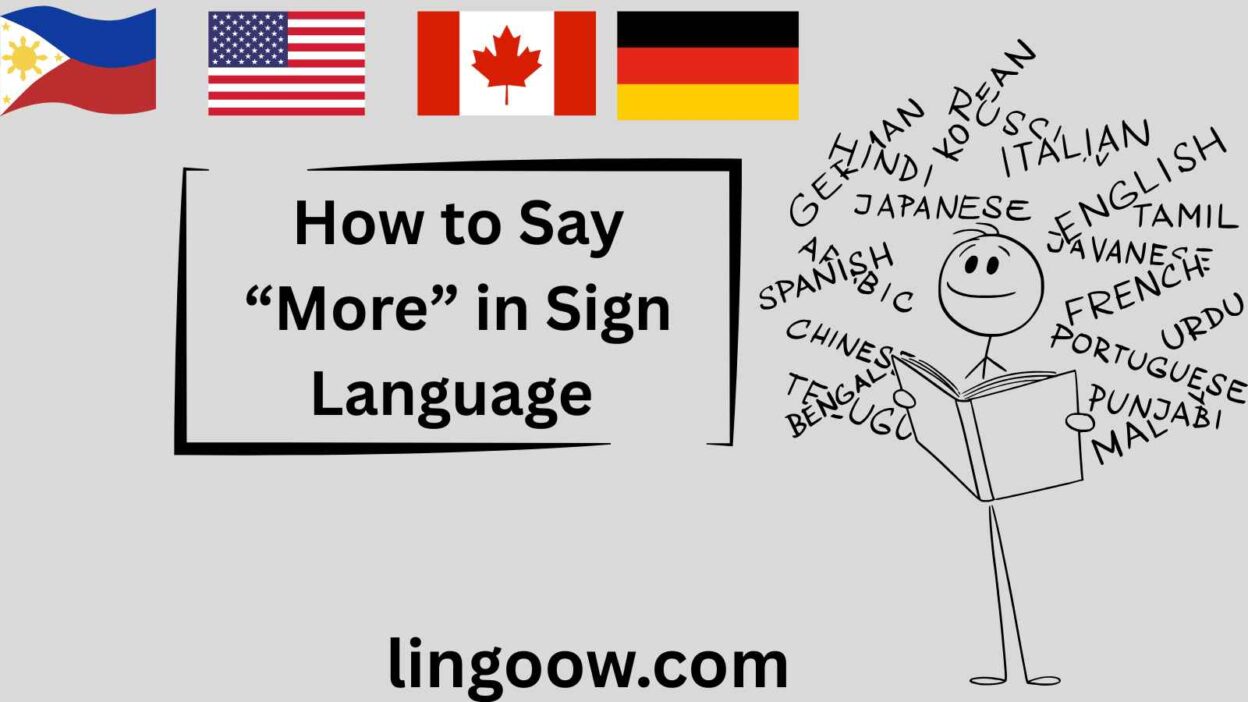Picture this: a baby, barely a year old, sitting in a high chair. Their little hands come together in a simple motion — fingertips tapping fingertips.
They look up at their parent with wide, eager eyes. No words yet, but the message is clear: they want more. More food, more fun, more love.
That small gesture — the American Sign Language (ASL) sign for “more” — captures something profoundly human. It’s not just about quantity. It’s about connection, desire, and the innate urge to continue what feels good. Across every culture, language, and era, “more” represents hope, curiosity, and longing — a bridge that connects our hearts through communication.
Let’s explore how this powerful concept — “more” — is expressed not just in sign language, but in languages and cultures around the world.
How to Say “More” in American Sign Language (ASL)
In ASL, the sign for “more” is simple yet expressive.
How to do it:
- Bring the fingertips of both hands together to form two flat “O” shapes.
- Tap them together twice.
This sign is often one of the first gestures taught to children — both hearing and deaf — because it’s easy, universal, and emotionally meaningful. It represents a request not only for physical things like food but also for emotional fulfillment: more hugs, more playtime, more connection.
Table: “More” in Different Languages
| Language | Word/Phrase for “More” | Cultural or Linguistic Insight |
|---|---|---|
| English | More | Rooted in Old English “māra,” meaning greater or larger. |
| French | Plus (pronounced “ploo”) | Also used in math and expressions like “encore plus” (even more). |
| Spanish | Más | Central in emotional expressions like “te quiero más” (I love you more). |
| Italian | Più | Used frequently in music and art to express intensity — e.g., più forte (louder). |
| German | Mehr | Represents abundance and ambition — often seen in “mehr als genug” (more than enough). |
| Mandarin Chinese | 更多 (gèng duō) | Combines “more” with “many,” emphasizing collective quantity. |
| Hindi | और (aur) | Symbolizes continuation — “aur” connects ideas and desires alike. |
| Japanese | もっと (motto) | Common in emotional contexts, like “もっと愛して” (love me more). |
| Korean | 더 (deo) | Frequently used to show effort or passion — “더 열심히” (try harder). |
| Arabic | أكثر (akthar) | Deeply tied to respect and abundance — “شكراً أكثر” (thanks more). |
| Swahili | Zaidi | Rooted in generosity — used in trade and emotional sharing. |
| Zulu | Okuningi | Reflects community abundance — “more for all” rather than one. |
| Maori | Ānō | Carries a spiritual tone, meaning “again” or “more” in a cyclical sense. |
| Hawaiian | Hou | Means “again” or “more” — seen in the phrase “Aloha hou” (love again). |
| Cherokee | ᎯᏍᎩ (hisgi) | Implies continuation or addition, reflecting balance in nature. |
European Languages: Expressions of “More” Across the Continent
In Europe, “more” often conveys ambition, emotion, and artistry.
- French “Plus” is both mathematical and emotional — it embodies refinement and the constant pursuit of “something extra.”
- Spanish “Más” vibrates with emotion; from love songs to daily speech, it carries passion — “un poco más” (a little more) is a phrase full of warmth.
- Italian “Più” finds life in opera and art — it’s not just a word, it’s a crescendo.
- German “Mehr” is practical and aspirational, reflecting the culture’s drive for precision and excellence.
Across Europe, “more” symbolizes progress and desire for improvement, often reflecting personal growth or artistic elevation.
Asian Languages: The Many Meanings of “More”
Asia’s languages offer fascinating interpretations of “more.”
- In Mandarin Chinese (更多 / gèng duō), the phrase is often about expansion — more opportunities, more harmony.
- In Hindi (और / aur), “more” connects ideas — both linguistically and emotionally. It’s used to join thoughts: “aur bolo” (say more).
- Japanese (もっと / motto) carries emotional weight — “もっと頑張って” (try harder) inspires self-improvement.
- Korean (더 / deo) symbolizes determination and growth — a core value in Korean culture.
- Arabic (أكثر / akthar) reflects abundance, respect, and blessing — often used in expressions of gratitude and praise.
Across Asian societies, “more” embodies both personal progress and collective well-being — a reflection of harmony between self and community.
African Languages: A Celebration of Abundance
Africa’s linguistic diversity offers beautiful interpretations of “more.”
- In Swahili (zaidi), “more” is generous — tied to trade, sharing, and community.
- Zulu (okuningi) translates to “many things,” symbolizing togetherness and abundance.
- Yoruba (siwaju) often implies growth or advancement — moving forward “more” into life.
- Amharic (በበለጠ / be-beleṭa) expresses blessing — “more” as divine favor.
Across the African continent, “more” often represents growth, giving, and gratitude, rather than mere possession.
Indigenous & Island Languages: The Spirit of Continuity
For Indigenous and island cultures, “more” isn’t always about material increase — it often carries spiritual or cyclical meanings.
- Maori (Ānō) conveys “again” — a renewal of energy or life.
- Hawaiian (Hou) means “more” or “again,” as in “aloha hou” — love reborn.
- Cherokee (ᎯᏍᎩ / hisgi) ties the idea of “more” to harmony and balance in nature.
- Samoan (Atili) emphasizes intensity or deepening — “atili lelei” (better, more good).
These languages teach us that “more” doesn’t always mean accumulation — it often means renewal, connection, and respect for cycles.
Cultural Insights: The Evolution of “More”
The word “more” has traveled through centuries of human language, evolving from Old English māra and Latin maior (greater), to countless modern variations. Yet its essence has remained unchanged — it’s always been about the yearning of the human heart.
In spiritual traditions, “more” often meant seeking enlightenment or deeper love. In modern societies, it’s about innovation and progress. But universally, it reflects the same impulse — to expand, connect, and evolve.
Proverbs About “More” Around the World
- English: “Less is more.” (A reminder that more value can come from simplicity.)
- Spanish: “Más vale tarde que nunca.” (Better late than never — more time is better than none.)
- Japanese: “欲は身を破る” (Yoku wa mi o yaburu) — “Desire destroys the body.” (Cautioning against too much “more.”)
- Swahili: “Zaidi si bora.” (More is not always better.)
- French: “Encore un peu, toujours plus.” (Always a little more — both ambition and temptation.)
Proverbs show that while “more” is a universal concept, cultures interpret its balance differently — some celebrate it, others warn against excess.
FAQs
1. Why does “more” sound similar in many languages?
Because many European and Indo-Iranian languages share common roots from Proto-Indo-European, ancient linguistic ancestors that influenced modern tongues.
2. What is the oldest known form of “more”?
The Old English “māra” and Latin “maior” both meant “greater” and can be traced back over two millennia.
3. Why is “more” so emotionally powerful?
Because it expresses human desire — not just for things, but for connection, improvement, and meaning.
Conclusion:
From a baby’s first ASL sign to a poet’s whispered “motto,” the word “more” echoes across languages and cultures as a call of the human spirit.
It’s a plea for connection, a drive for progress, and a reminder that no matter where we live or what language we speak, we all share the same longing — to love, learn, and live a little more.
So, what does “more” mean to you?
💬 Share in the comments: how do you say “more” in your language — and what does it mean in your heart?




